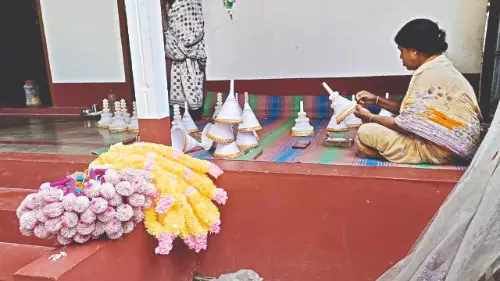Shola artists struggle to keep tradition alive amid rising costs

Cooch Behar: With Durga Puja just days away, households are busy in preparations, and one essential item on the list is the shola-made ‘Kadam’ flower. Across Tufanganj, Dinhata, and Mathabhanga in Cooch Behar district, artisans from the Malakar community work round the clock to meet demands, especially during the Durga Puja. Yet behind their busy hands lies a growing concern — the fading interest of the next generation and the struggle to sustain the craft.
Shola is a milky-white, spongy plant stem found in marshy areas of Bengal, used to craft intricate decorations and ornaments for traditional ceremonies and festivals.
In Dinhata’s Bhetaguri Balapara, nearly 20 Malakar families depend on this traditional art. Every household is engaged in crafting step flowers for the festive season, alongside other decorative items such as crowns and ornaments. These products are sent not only to different parts of Bengal but also to Assam and Bihar.
Despite strong demand, artisans say they are not getting a fair price. The cost of raw shola, once available free of cost, has soared, while cheaper thermocol alternatives have flooded the market. As a result, many artisans are forced to sell their painstakingly crafted items at lower rates, cutting into their livelihood.
“During Durga Puja, we barely find time to rest as we work day and night making Kadam flowers,” said Dhirendra Malakar, a veteran artisan from Bhetaguri Balapara. “We have inherited this craft from our ancestors, but the younger generation is reluctant to continue. They feel jobs in companies promise salaries of Rs.25,000–30,000, which is impossible to earn here. Still, I will keep doing this work for as long as I can.”
Women of the Malakar households are equally involved, supporting the men in making the intricate decorations. But the rising costs remain a pressing challenge. “The price of shola has gone up a lot. Once, it was available free of cost, but now it is expensive. On the other hand, thermocol products are being sold much cheaper,” said Sanjeev Malakar, another artisan. “Although the demand for shola items remains high, we don’t get the right price. If the government intervenes, our craft and industry will survive.”
For now, the Malakars continue to toil silently, preserving a centuries-old tradition. But unless support comes in the form of fair pricing and recognition, one of Bengal’s finest indigenous art forms may slowly fade away.



